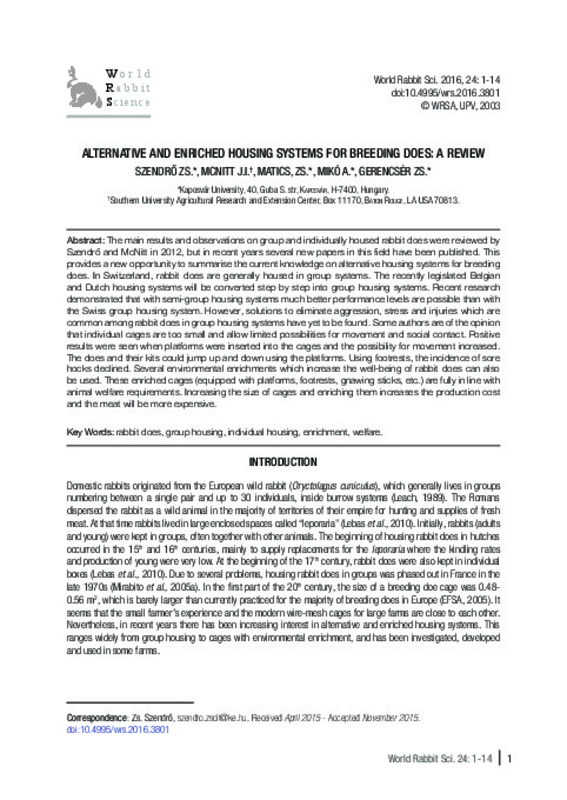JavaScript is disabled for your browser. Some features of this site may not work without it.
Buscar en RiuNet
Listar
Mi cuenta
Estadísticas
Ayuda RiuNet
Admin. UPV
Alternative and enriched housing systems for breeding does: a review
Mostrar el registro sencillo del ítem
Ficheros en el ítem
| dc.contributor.author | Szendrő, ZS.
|
es_ES |
| dc.contributor.author | McNitt, J.I.
|
es_ES |
| dc.contributor.author | Matics, ZS.
|
es_ES |
| dc.contributor.author | Mikó, A.
|
es_ES |
| dc.contributor.author | Gerencsér, ZS.
|
es_ES |
| dc.date.accessioned | 2016-09-14T13:07:07Z | |
| dc.date.available | 2016-09-14T13:07:07Z | |
| dc.date.issued | 2016-03-22 | |
| dc.identifier.issn | 1257-5011 | |
| dc.identifier.uri | http://hdl.handle.net/10251/69500 | |
| dc.description.abstract | [EN] The main results and observations on group and individually housed rabbit does were reviewed by Szendrő and McNitt in 2012, but in recent years several new papers in this field have been published. This provides a new opportunity to summarise the current knowledge on alternative housing systems for breeding does. In Switzerland, rabbit does are generally housed in group systems. The recently legislated Belgian and Dutch housing systems will be converted step by step into group housing systems. Recent research demonstrated that with semi-group housing systems much better performance levels are possible than with the Swiss group housing system. However, solutions to eliminate aggression, stress and injuries which are common among rabbit does in group housing systems have yet to be found. Some authors are of the opinion that individual cages are too small and allow limited possibilities for movement and social contact. Positive results were seen when platforms were inserted into the cages and the possibility for movement increased. The does and their kits could jump up and down using the platforms. Using footrests, the incidence of sore hocks declined. Several environmental enrichments which increase the well-being of rabbit does can also be used. These enriched cages (equipped with platforms, footrests, gnawing sticks, etc.) are fully in line with animal welfare requirements. Increasing the size of cages and enriching them increases the production cost and the meat will be more expensive. | es_ES |
| dc.language | Inglés | es_ES |
| dc.publisher | Editorial Universitat Politècnica de València | |
| dc.relation.ispartof | World Rabbit Science | |
| dc.rights | Reserva de todos los derechos | es_ES |
| dc.subject | Rabbit does | es_ES |
| dc.subject | Group housing, | es_ES |
| dc.subject | Individual housing | es_ES |
| dc.subject | Enrichment | es_ES |
| dc.subject | Welfare | es_ES |
| dc.title | Alternative and enriched housing systems for breeding does: a review | es_ES |
| dc.type | Artículo | es_ES |
| dc.date.updated | 2016-09-06T09:47:47Z | |
| dc.identifier.doi | 10.4995/wrs.2016.3801 | |
| dc.rights.accessRights | Abierto | es_ES |
| dc.description.bibliographicCitation | Szendrő, Z.; Mcnitt, J.; Matics, Z.; Mikó, A.; Gerencsér, Z. (2016). Alternative and enriched housing systems for breeding does: a review. World Rabbit Science. 24(1):1-14. https://doi.org/10.4995/wrs.2016.3801 | es_ES |
| dc.description.accrualMethod | SWORD | es_ES |
| dc.relation.publisherversion | https://doi.org/10.4995/wrs.2016.3801 | es_ES |
| dc.description.upvformatpinicio | 1 | es_ES |
| dc.description.upvformatpfin | 14 | es_ES |
| dc.type.version | info:eu-repo/semantics/publishedVersion | es_ES |
| dc.description.volume | 24 | |
| dc.description.issue | 1 | |
| dc.identifier.eissn | 1989-8886 |








